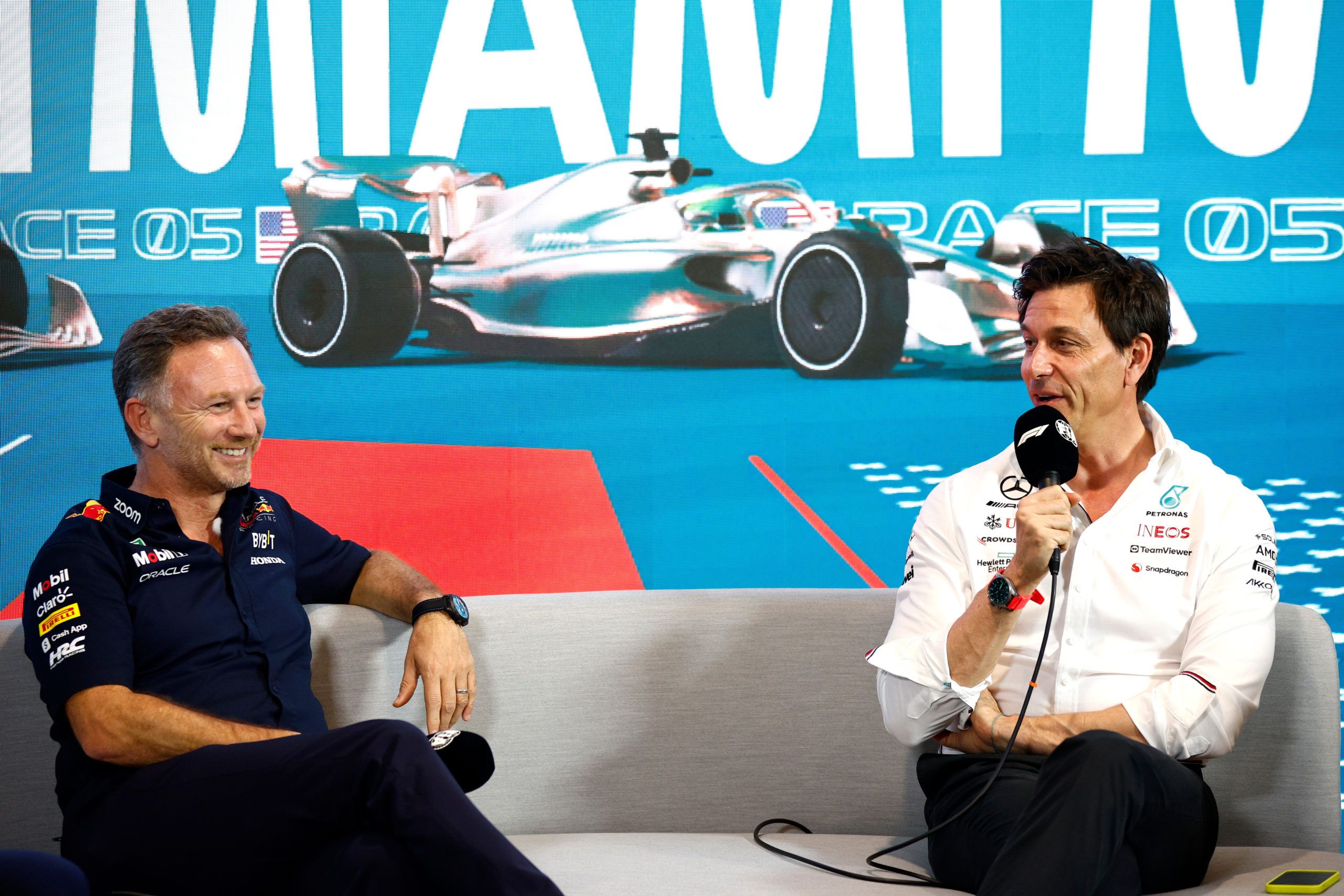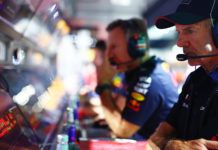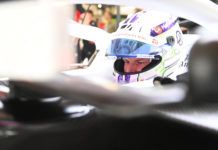Christian Horner and Toto Wolff talk about the F1 2026 regulations and how they are being looked at, with Max Verstappen chipping in.
With the discussions ongoing for F1 2026 regulations with regards to engine and technical, there has been questions raised already about the competitiveness due to the high weight of the proposed cars. There are positives but the one downside will create a spiral.
In fact, Red Bull’s Horner terms it as ‘Frankestein’ technical rule which will force teams to find ways on the chassis side to generate performance. He feels that the new F1 cars will eliminate DRS’ effectiveness and the tow effect will be minimal too overall.
Red Bull driver Max Verstappen feels the same having seen the simulator numbers. He terms it bad straight up. Mercedes’ Toto Wolff calls out Horner on the topic of engine and its effectiveness, which is why the Austrian thinks the Brit is pushing for a change.
Here’s what has been said by the F1 personnel –
Horner: “Well, I think that we are in a position where obviously we’re dealing with a power unit now as well as the chassis for ’26 and I think that one of the big issues, and one of the big impacts for 2026 is weight. You’re looking at pretty much a 30 kilogram swing on cars are already approaching sports car type of weight through the cooling that’s going to be required and so on. I think there’s some very positive things about 2026 and the sustainable fuel and so on is extremely positive but I think that perhaps where we need to pay urgent attention before it’s too late, is to look at the ratio between combustion power and electrical power to ensure that we’re not creating a technical Frankenstein which will require the chassis to compensate to such a degree with movable aero and to reduce the drag to such a level that the racing will be affected, that there will be no tow effect, there will be no DRS because effectively you’re running at that at all points in time. And that the characteristics of these engines are just not… the combustion engine just doesn’t become a generator to recharge a battery. And I think that could easily be addressed with just tuning the ratio between combustion and electrical power. And because the engine regulations… We still have two and a half years, and I think if there is a slight redress it would then create potentially a better platform for the chassis because otherwise the chassis regs that are undefined yet and uncommitted, we’re going to be trying to cater for those compromises and so I think you’ve got to look at the thing holistically from both a technical point of view but the most important thing is: what is Formula 1?
“And Formula 1 needs to be wheel-to-wheel racing. We can’t afford to lose that challenge of drivers downshifting on straights to regenerate batteries. So I know the FIA are taking it very seriously, and they’re looking at it very closely as the simulations become more advanced. We’ve got approximately 50/50 at the moment. It doesn’t need to change that much but to cater for the circuits, maybe even a 5% swing could have a significant effect, even a 10% swing, because obviously one of the biggest weight additions as well as the cell weight. The size of the battery is colossal for these 2026 regs and I think with the work that’s going on with sustainable fuel and then the car has been effectively carbon zero, it’s phenomenal. So I think if we just tune that ratio, I think very quickly you could take the dependence away from having the need for active aero and constantly movable diffusers and wings and the complexity that will bring.”
Verstappen: “Yeah, I mean, I’ve been talking about that as well with the team and I’ve seen the data already on the simulator as well. To me, it looks pretty terrible. I mean, if you go flat-out on the straight at Monza, I don’t know what it is, like four or five hundred before the end of the straight, you have to downshift flat-out because that’s faster. I think that’s not the way forward. Of course, probably that’s one of the worst tracks. But for me, the problem is, it looks like it’s going to be an ICE competition, like whoever has the strongest engine will have a big benefit. But I don’t think that should be the intention of Formula 1, because then you will start a massive development war again, and it will become quite expensive to find, probably a few horsepower here and there.
“I think it actually should be opposite. Plus, the cars probably have a lot less drag. So, it will be even harder to overtake on the straight. And then I think yeah, you have the active aerodynamics, which you can’t control. Well, it will be… I don’t know… the system will control it for you. Which then I think makes it very awkward to drive, because I prefer to control it myself. Of course, when you’re behind someone, maybe you need more front or more rear. These kind of things. If the system starts to control that for you, I don’t think that’s the right way forward. Plus, the weight is going up again. So yeah, we have to seriously look at this because I mean, ’26 is not that far away. And at the moment, to me, it looks very bad from all the numbers and what I see from the data already. So, it’s not something I’m very excited about at the moment.”
Bravi: “For sure this is a question also for the pure manufacturers, but I agree that, of course, we can always improve because it’s important to keep the DNA of Formula 1. For Audi, it’s been important; this new regulation has been the factor that has pushed them to enter into Formula 1 and I think it’s important for everybody and all the stakeholders that Audi will enter and that we are attractive for new manufacturers. The focus on sustainability is crucial for the car manufacturers so we don’t need to forget this. Of course we can improve, we can improve and all the stakeholders are working to have a good show, to have a good car. Then it will be a matter of ratio, difficult to say, but what Christian said that I agree we need to have an holistic approach. It’s not just a matter of PU, it’s a matter of the overall package: the chassis and the engines.”
Post Horner’s comments, Wolff responded –
Wolff: “I think what frightens Horner more maybe is that his engine programme is not coming along and maybe he wants to kill it that way. You always have to question what is the real motivation to say something like that. That is an exciting project to aim for. How does the modern Formula 1 car of 2026 look like? How can we make it aerodynamically so efficient and capable that it can compensate for the lack of combustion engine output? That should all excite us because we will come up with new concepts of Formula 1 cars that will be great. That’s not going to happen. Zero chance. Capital letters. So, I don’t know why these things are coming up. We’ve developed the regulations over many years with all the auto manufacturers being involved, it was a compromise that attracted Audi to finally join the sport. For Honda to stay in there. It’s the best possible case that one could imagine for Formula 1. Is it challenging? Our chassis designers are saying ‘well, how we are going to do this?’. Yeah. Super. But, zero [chance]. These regulations are not going to change anymore. They’re not going to be postponed anymore. Because the world needs to show innovation about sustainability, we need to reduce emissions and we are super excited.”
Post Wolff’s comments, Horner responded –
Horner: “Unfortunately, that’s typically Toto, where he’s just focused on self-performance. My interest is actually about the sport rather than self-gain. It is still way too early to say who’s going to have a competitive or uncompetitive engine in 2026. For me, the most important thing is, from a sports point of view, that we all have a collective responsibility to work with the FIA and the commercial rights holder, to ensure that the product is as good as it can be. Otherwise, we’ve all failed. The regulations are a hybrid of what was originally intended. Of course, it’s only as you work through a set of regulations that you find out where their limitations are. I think the FIA are being very responsible in terms of doing their due diligence. And, I think, certain teams share very similar opinions on that. I think so. I think they have a capable team and that they’re aware of what the challenges are. You have heard recently the [FIA] president’s comment about weight. Now, that’s not an easy thing to reduce, when you look at the increase in cell size that we have and the cooling that obviously goes with that.”
Here’s Toto Wolff on Lewis Hamilton’s radio call
Here’s Sergio Perez on Carlos Sainz’s intimidation call
Here’s Max Verstappen poking fun on articles
Here’s Lewis Hamilton, Max Verstappen on development ban



















